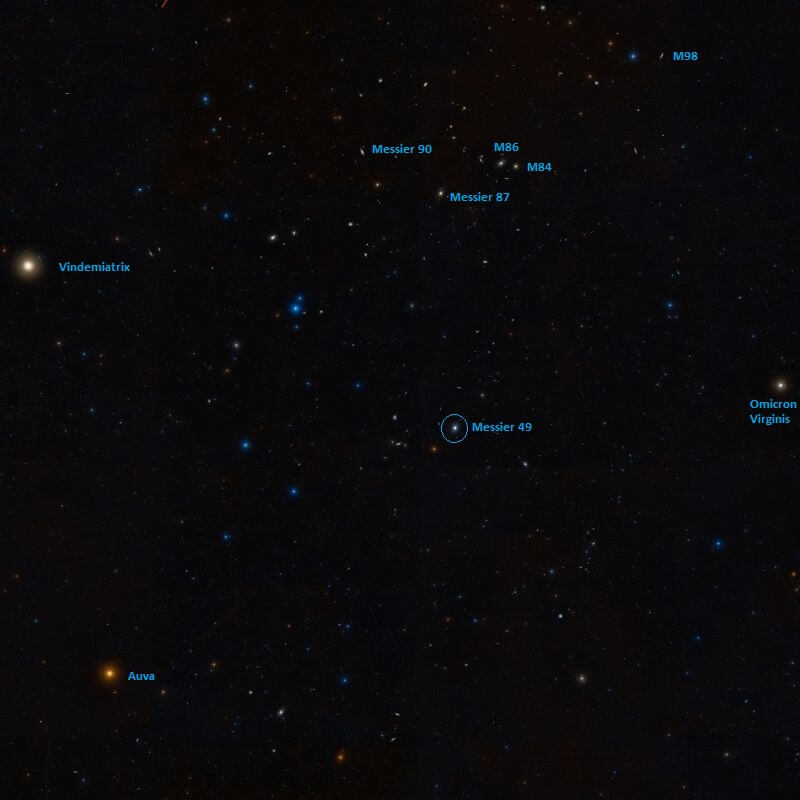Welcome back to Messier Monday! In our ongoing tribute to the great Tammy Plotner, we take a look at Orion’s Nebula’s “little brother”, the De Marian’s Nebula!
During the 18th century, famed French astronomer Charles Messier noted the presence of several “nebulous objects” in the night sky. Having originally mistaken them for comets, he began compiling a list of them so that others would not make the same mistake he did. In time, this list (known as the Messier Catalog) would come to include 100 of the most fabulous objects in the night sky.
One of these objects is the elliptical galaxy known as Messier 49 (aka. NGC 4472). Located in the southern skies in the constellation of Virgo, this galaxy is one several members of the Virgo Cluster of galaxies and is located 55.9 million light years from Earth. On a clear night, and allowing for good light conditions, it can be seen with binoculars or a small telescope, and will appear as a hazy patch in the sky.
Description:
Messier 49 is the brightest of the Virgo Cluster member galaxies, which is pretty accurate considering it’s only about 60 million light years away and may span an area as large as 160,000 light years. It is a huge system of globular clusters, much less concentrated than Virgo cluster member M87 – but a giant none the less. As Stephen E. Zep (et al) wrote in a 2000 study:
“We present new radial velocities for 87 globular clusters around the elliptical galaxy NGC 4472 and combine these with our previously published data to create a data set of velocities for 144 globular clusters around NGC 4472. We utilize this data set to analyze the kinematics of the NGC 4472 globular cluster system. The new data confirm our previous discovery that the metal-poor clusters have significantly higher velocity dispersion than the metal-rich clusters in NGC 4472. The very small angular momentum in the metal-rich population requires efficient angular momentum transport during the formation of this population, which is spatially concentrated and chemically enriched. Such angular momentum transfer can be provided by galaxy mergers, but it has not been achieved in other extant models of elliptical galaxy formation that include dark matter halos. We also calculate the velocity dispersion as a function of radius and show that it is consistent with roughly isotropic orbits for the clusters and the mass distribution of NGC 4472 inferred from X-ray observations of the hot gas around the galaxy.”
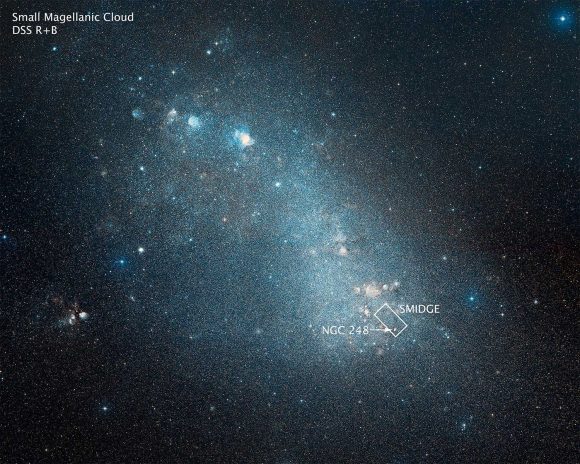
However, there was something going on in the mass structure of M49 that astronomers were curious about… Something they couldn’t quite explain. Was it dark matter? As M. Lowenstein wrote in a 1992 study:
“An attempt to constrain the total mass distribution of the well-observed giant elliptical galaxy NGC 4472 is realized by constructing simultaneous equilibrium models for the gas and stars using all available relevant optical and X-ray data. The value of <?>, the emission-weighted average value of kT, derived from the Ginga spectrum, <?> = 1.9 ± 0.2 keV, can be reproduced only in hydrostatic models where nonluminous matter comprises at least 90% of the total mass. However, in general, these mass models are not consistent with observed projected stellar and globular cluster velocity dispersions at moderate radii.”
The next thing you know, nuclear outburst were discovered – the product of interaction with a neighboring galaxy. As B. Biller (et al) indicated in a 2004 study:
“We present the analysis of the Chandra ACIS observations of the giant elliptical galaxy NGC 4472. The Chandra Observatory’s arcsec resolution reveals a number of new features. Specifically: 1) an ~8 arc min streamer or arm (this corresponds to a linear size of 36 kpc) extending southwest of the galaxy and an assymetrical, somewhat truncated streamer to the northeast. Smaller, morphologically similar structures are observed in NGC 4636 and are explained as shocks from a nuclear outburst in the recent past. The larger size of the NGC 4472 streamers requires a correspondingly higher energy input compared to the NGC 4636 case. The asymmetry of the streamers may be due to the interaction of NGC 4472 with the ambient Virgo cluster gas. 2) A string of small, extended sources south of the nucleus. These sources may stem from an interaction of NGC 4472 with the galaxy UGC 7637. 3) X-ray cavities corresponding to radio lobes, where expanding radio plasma has evacuated the X-ray emitting gas. We also present a luminosity function for the X-ray point sources detected within NGC 4472 which we compare to that for other early type galaxies.”
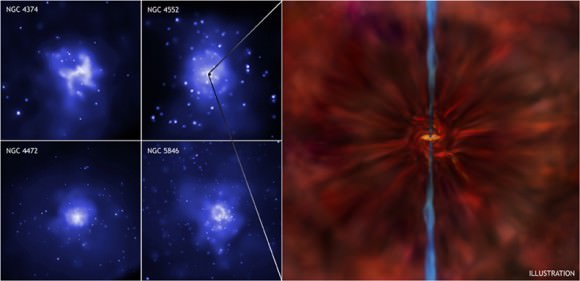
But the very best was yet to come… the discovery of a black hole! According to NASA, the results from NASA’s Chandra X-ray Observatory, combined with new theoretical calculations, provide one of the best pieces of evidence yet that many supermassive black holes are spinning extremely rapidly. The images on the left show 4 out of the 9 large galaxies included in the Chandra study, each containing a supermassive black hole in its center.
The Chandra images show pairs of huge bubbles, or cavities, in the hot gaseous atmospheres of the galaxies, created in each case by jets produced by a central supermassive black hole. Studying these cavities allows the power output of the jets to be calculated. This sets constraints on the spin of the black holes when combined with theoretical models. The Chandra images were also used to estimate how much fuel is available for each supermassive black hole, using a simple model for the way matter falls towards such an object.
The artist’s impression on the right side of the main graphic shows gas within a “sphere of influence” falling straight inwards towards a black hole before joining a rapidly spinning disk of matter near the center. Most of the material in this disk is swallowed by the black hole, but some of it is swept outwards in jets (colored blue) by quickly spinning magnetic fields close to the black hole.
Previous work with these Chandra data showed that the higher the rate at which matter falls towards these supermassive black holes, the higher their power output is in jets. However, without detailed theory the implications of this result for black hole behavior were unclear. The new study uses these Chandra results combined with leading theoretical models for the production of jets, plus general relativity, to show that the supermassive black holes in these galaxies must be spinning at close to the maximum rate. If black holes are spinning at this limit, material can be dragged around them at close to the speed of light, the speed limit from Einstein’s theory of relativity.
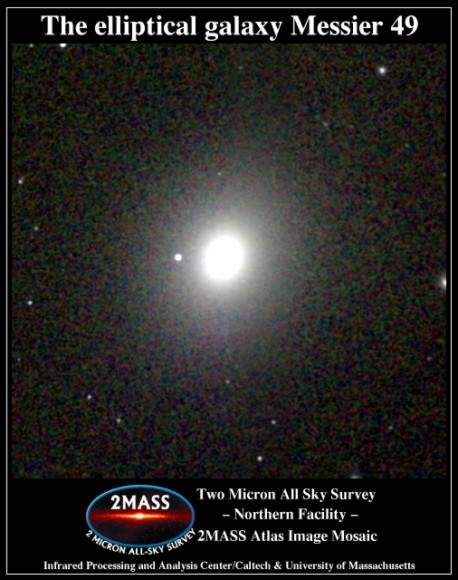
History of Observation:
According to SEDS, M49 was the first member of the Virgo cluster of galaxies to be discovered, by Charles Messier, who cataloged it on February 19th, 1771. As he recorded in his notes at the time:
“Nebula discovered near the star Rho Virginis. One cannot see it without difficulty with an ordinary telescope of 3.5-feet [FL]. The Comet of 1779 was compared by M. Messier with this nebula on April 22 and 23: The comet and the nebula had the same light. M. Messier has reported this nebula on the chart of the route of the comet, which appeared in the volume of the Academy of the same year 1779. Seen again on April 10, 1781.” Eight years later, on April 22, 1779, on the occasion of following the comet of that year, and on the hunt for finding more nebulous objects in competition to other observers, Barnabas Oriani independently rediscovered this ‘nebula’: “Very pale and looking exactly like the comet [1779 Bode, C/1779 A1].”
In his Bedford Catalogue of 1844, Admiral William H. Smyth confused this finding with Messier’s discovery:
“A bright, round, and well-defined nebula, on the Virgin’s left shoulder; exactly on the line between Delta Virginis and Beta Leonis, 8deg, or less than half-way, from the former star. With an eyepiece magnifying 93 times, there are only two telescopic stars in the field, one of which is in the sp and the other in the sf quadrant; and the nebula has a very pearly aspect. This object was discovered by Oriani in 1771 [this is wrong: it was Messier who discovered it that year; Oriani found it only in 1779], and registered by Messier as a “faint nebula, not seen without difficulty,” with a telescope of 3 1/2 feet in length. It is a pity that this active and very assiduous astronomer could not have been furnished with one of the giant telescopes of the present days. Had he possessed efficient means, there can be no doubt of the augmentation of his useful and, in its day, unique Catalogue: a collection of objects for which sidereal astronomy must ever remain indebted to him.” This error was repeated by John Herschel in his General Catalogue of 1864 (GC), who also erroneously assigned this object to “1771 Oriani,” and also found its way into J.L.E. Dreyer’s NGC.
Let’s hope you don’t mistake it with the many other galaxies nearby!
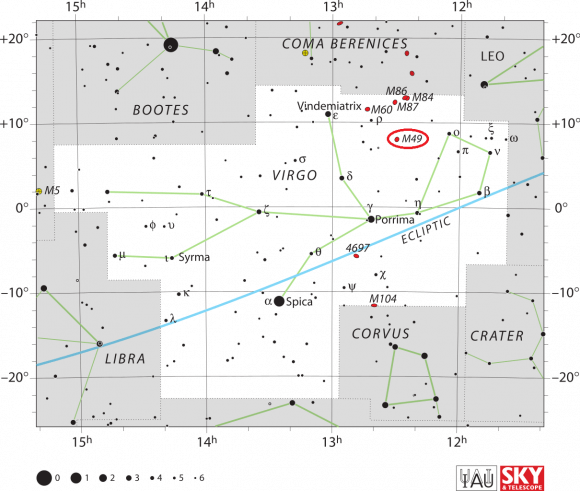
Locating Messier 49:
Galaxy hopping isn’t an easy chore and it takes some practice. Starting looking for M49 about halfway between Epsilon and Beta Virginis. Use Gamma to help triangulate your position. At near magnitude 8, Messier 49 is quite binocular possible and would show under dark sky conditions as a faint, very small egg shaped fog. However, it will not show in a finderscope of a telescope – but the nearby stars will.
Use their patterns to help guide you there. Because galaxies require dark skies, M49 cannot be found under urban conditions or during moonlit nights. In telescopes as small as 70mm, it will appear as a nebulous egg shape and become brighter – but no more resolved to larger instruments. To assist in location, begin with lowest magnification and increase magnification once found to darken background field.
And here are the quick facts to help you get started!
Object Name: Messier 49
Alternative Designations: M49, NGC 4472
Object Type: Elliptical Galaxy
Constellation: Virgo
Right Ascension: 12 : 29.8 (h:m)
Declination: +08 : 00 (deg:m)
Distance: 60000 (kly)
Visual Brightness: 8.4 (mag)
Apparent Dimension: 9×7.5 (arc min)
We have written many interesting articles about Messier Objects here at Universe Today. Here’s Tammy Plotner’s Introduction to the Messier Objects, , M1 – The Crab Nebula, M8 – The Lagoon Nebula, and David Dickison’s articles on the 2013 and 2014 Messier Marathons.
Be to sure to check out our complete Messier Catalog. And for more information, check out the SEDS Messier Database.
Sources:

